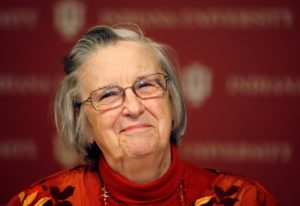
Elinor Ostrom
1933-2012

In 2009, Elinor Ostrom, along with oliver e. williamson, was awarded the Nobel Prize in economics. Ostrom, the only woman to ever win the prize, received it “for her analysis of economic governance, especially the commons.” She demonstrated “how local property can be successfully managed by local commons without any regulation by central authorities or privatization.”
In her research, Ostrom applied rational choice theory and insights from development economics to ecological preservation. Yet she had little formal economics training, having earned all her degrees in political science. Possibly for that reason, Ostrom differed from most modern economists, basing her research on case studies. She studied arrangements in irrigation, fisheries, and forest use in a wide range of countries, including Nepal, Spain, Indonesia, Nigeria, Bolivia, Sweden, and the United States.
Most economists are familiar with the late Garrett Hardin’s classic article, “The Tragedy of the Commons” (see Tragedy of the Commons). Hardin’s idea was that when no one owns a resource, it is overused because no one can control its usage and each person has an incentive to use it before others do. This insight has helped us understand much human behavior and has led people to advocate either having the resource privately owned or having it controlled by government.
Ostrom’s work suggested, contrary to conventional thinking, that communities are able to self-organize in ways that punish those who free ride on the common resource. Examining dozens of real-world arrangements, she found instances of communal ownership that worked—that is, that did not lead to the tragic outcomes envisioned by Hardin—as well as ones that did not. Were there systematic differences? Yes, and interestingly, the ones that worked did have a kind of property rights system, just not private ownership. Based on her work, Ostrom proposed several guidelines, which the Nobel committee highlighted, for managing common-pool resources. Among them are that rules should clearly define who gets what, good conflict resolution methods should be in place, people’s duty to maintain the resource should be proportional to their benefits, monitoring and punishing is done by the users or someone accountable to the users, and users are allowed to participate in setting and modifying the rules. Notice the absence of top-down government solutions.
In a 2006 article co-authored with Harini Nagendra, Ostrom wrote: “We conclude that simple formulas focusing on formal ownership, particularly one[s] based solely on public [government] ownership of forest lands, will not solve the problem of resource use.” This, they believed, is largely because “When users are genuinely engaged in decisions regarding rules affecting their use, the likelihood of them following the rules and monitoring others is much greater than when an authority simply imposes rules.”
Indeed, in a 2008 interview on EconTalk1, Mercatus Center economist Karol Boudreaux noted that Garth Owen-Smith, who helped solve the common-resource problem of elephants in Namibia, drew explicitly on Ostrom’s work. His solution was to ensure that local residents shared in the financial benefits from tourism and trophy hunting. If locals benefit from having a resident population of elephants, they are much less likely to poach and more likely to stop other poachers.
Forms of organization similar to those studied by Ostrom can be found in many other human interactions. Organized sports provide one such example. Sports organizations, from local pick-up games to the National Football League, create or codify internal rules and govern themselves. The U.S. Government never determined a “false-start” to be a football penalty, for example, and yet the rule is respected by the penalized team.
Some have summarized Ostrom’s work by saying that institutions other than free markets often work well. But her findings do not conflict with a free economy: she observed communities sustainably managing shared resources without any central planning. Ostrom advocated dispersed decision centers, rather than a top-down hierarchy, because local actors possess information a central planning group cannot. Her skepticism about central planning was based, in part, on how badly top-down solutions worked in poor countries. Furthermore, institutional diversity allows ideas to compete.
Ostrom earned her B.A. degree in 1954, her M.A. in 1962, and her PhD in 1965, all in political science and all from UCLA. Getting a Ph.D. in political science at UCLA in the early 1960s was a challenge for a woman. In her biography on the Nobel site, Ostrom writes:
Political Science at that time was also skeptical about admitting any women to their Ph.D. program as they feared that only a city college would employ a woman with a Ph.D. That was not a good placement for building the reputation of the UCLA department. I was, however, admitted in a class of 40 students with three other women. We were told after we began our program that the faculty had a very heated meeting in which they criticized the Departmental Committee for admitting any women and offering them assistantships. Fortunately, our fellow male graduate students were friendly and encouraged us all to continue in our program.
She was a professor at Indiana University in Bloomington from 1965 to 1991. In 1973, with her husband, political scientist Vincent Ostrom, she co-founded the Workshop in Political Theory and Policy Analysis at Indiana University, where she was a co-director until 2009.
About the Author
David R. Henderson is the editor of The Concise Encyclopedia of Economics. He is also an emeritus professor of economics with the Naval Postgraduate School and a research fellow with the Hoover Institution at Stanford University. He earned his Ph.D. in economics at UCLA.
Selected Works
Footnotes
Related Links
Peter Boettke on Elinor Ostrom, Vincent Ostrom, and the Bloomington School, an EconTalk podcast, November 30, 2009.
Richard Davies on Extreme Economies, an EconTalk podcast, March 9, 2020
Peter Boettke, The Role of the Economist in a Free Society: The Art of Political Economy, at Econlib, September 2, 2019.
